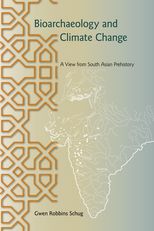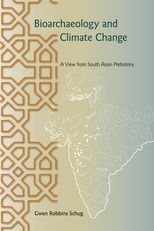Bioarchaeology and Climate Change: A View from South Asian Prehistory
Bioarchaeology and Climate Change: A View from South Asian Prehistory
Cite
Abstract
During the second millennium B.C. hundreds of villages were founded in peninsular India. The people of the Deccan Chalcolithic period relied on farming drought-resistant barley and wheat. They raised cattle, sheep, and goats; maintained hunting and foraging traditions; and utilized the resources gathered from local lakes and forest habitats for subsistence, construction, and fuel. Throughout this time, Chalcolithic people successfully colonized the peninsula despite the challenges of living in a semi-arid climate and unpredictable monsoon rainfall. By 1400 B.C. their settlements were thriving, populations were growing, and large regional centers were established. Yet, around 1000 B.C., the majority of these settlements were deserted. This book uses evidence from paleoclimate research, archaeology, and human skeletal material to examine life and death at three villages occupied during this time. Innovative methods of bioarchaeological analysis reveal complexity in the interactions between humans and their environment and suggest a new model for understanding this period of India's prehistory. Questions about human interactions with the environment thousands of years ago in India are interesting from an academic standpoint, but the insights we gain into the past are relevant in a contemporary context as we face the consequences of continued population growth, unsustainable lifestyles, degradation of local environments, and large-scale climate change. Having a longer view of the challenges, strategies, and consequences of human–environment interactions may prove helpful as we all develop strategies for dealing with contemporary environmental change.
-
Front Matter
-
1
Origins
Clark Spencer Larsen
-
2
The Western Deccan Plateau: Environment and Climate
Clark Spencer Larsen
-
3
Archaeology at Nevasa, Daimabad, and Inamgaon
Clark Spencer Larsen
-
4
Demography
Clark Spencer Larsen
-
5
Estimating Body Mass in the Subadult Skeleton
Clark Spencer Larsen
-
6
Reconstructing Health at Nevasa, Daimabad, and Inamgaon
Clark Spencer Larsen
-
7
Conclusion
Clark Spencer Larsen
-
End Matter
- Appendix A Burials from Daimabad: Archaeological Context and Grave Goods
- Appendix B Age Estimates for Subadults in Chalcolithic Samples
- Appendix C Long Bone Lengths (Mm) and Stature (Cm) for Individuals with Dental Age Estimates (Months)
- Appendix D Midshaft Femur Cross-Section Measurements for All Individuals with Intact Femur Midshafts
- Appendix E Stature and Body Mass Estimates for Deccan Chalcolithic Specimens
-
Notes
- Bibliography
- Index
Sign in
Personal account
- Sign in with email/username & password
- Get email alerts
- Save searches
- Purchase content
- Activate your purchase/trial code
Institutional access
-
Sign in through your institution
- Sign in with a library card Sign in with username/password Recommend to your librarian
Institutional account management
Sign in as administratorPurchase
Our books are available by subscription or purchase to libraries and institutions.
Purchasing information| Month: | Total Views: |
|---|---|
| February 2023 | 1 |
| March 2023 | 1 |
| November 2023 | 1 |
| January 2024 | 1 |
| January 2024 | 2 |
| January 2024 | 1 |
| January 2024 | 4 |
| January 2024 | 1 |
| January 2024 | 1 |




Get help with access
Institutional access
Access to content on Oxford Academic is often provided through institutional subscriptions and purchases. If you are a member of an institution with an active account, you may be able to access content in one of the following ways:
IP based access
Typically, access is provided across an institutional network to a range of IP addresses. This authentication occurs automatically, and it is not possible to sign out of an IP authenticated account.
Sign in through your institution
Choose this option to get remote access when outside your institution. Shibboleth/Open Athens technology is used to provide single sign-on between your institution’s website and Oxford Academic.
If your institution is not listed or you cannot sign in to your institution’s website, please contact your librarian or administrator.
Sign in with a library card
Enter your library card number to sign in. If you cannot sign in, please contact your librarian.
Society Members
Society member access to a journal is achieved in one of the following ways:
Sign in through society site
Many societies offer single sign-on between the society website and Oxford Academic. If you see ‘Sign in through society site’ in the sign in pane within a journal:
If you do not have a society account or have forgotten your username or password, please contact your society.
Sign in using a personal account
Some societies use Oxford Academic personal accounts to provide access to their members. See below.
Personal account
A personal account can be used to get email alerts, save searches, purchase content, and activate subscriptions.
Some societies use Oxford Academic personal accounts to provide access to their members.
Viewing your signed in accounts
Click the account icon in the top right to:
Signed in but can't access content
Oxford Academic is home to a wide variety of products. The institutional subscription may not cover the content that you are trying to access. If you believe you should have access to that content, please contact your librarian.
Institutional account management
For librarians and administrators, your personal account also provides access to institutional account management. Here you will find options to view and activate subscriptions, manage institutional settings and access options, access usage statistics, and more.